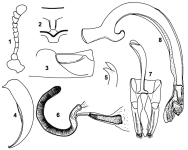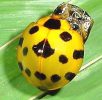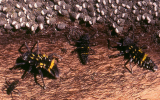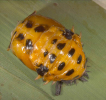Scientific name
Synonycha grandis (Thunberg)
Common name
Giant bamboo ladybird
Taxonomic position
Coleoptera: Coccinellidae: Coccinellinae: Coccinellini
Diagnosis
Length 10.5-13.0 mm, width 9.0-11.5 mm. Form round and very large, strongly convex.
Ground colour bright red, orange or yellow, with the following black markings: a transverse black marking in posterior half of head, below lower margins of eyes; a large, trapezoidal median marking at base of pronotum and thirteen spots on elytra-three common spots on sutural line, rest arranged in a 1-2-2
pattern on each elytron. Ventral side uniformly reddish or yellowish brown. Antenna (Fig. 1) short and compact, last segment spatulate. Tarsal claw (Fig. 5), female spermatheca (Fig. 6) and male genitalia (Figs. 7-8) as illustrated. This is one of the largest ladybirds of the world and perhaps the largest in India.  Figs. 1-8. Synonycha grandis: 1. Antenna; 2. Prosternal intercoxal process; 3. Postcoxal line
on first abdominal ventrite; 4. Elytral epipleuron; 5. Tarsal claw; 6. Female, spermatheca; 7-8. Male genitalia: 7. Tegmen, ventral view; 8. Sipho.
Figs. 1-8. Synonycha grandis: 1. Antenna; 2. Prosternal intercoxal process; 3. Postcoxal line
on first abdominal ventrite; 4. Elytral epipleuron; 5. Tarsal claw; 6. Female, spermatheca; 7-8. Male genitalia: 7. Tegmen, ventral view; 8. Sipho.Images
 Freshly emerged adult Freshly emerged adult

 Adult Adult
 Larvae feeding on bamboo aphid, Pseudoregma bambusicola Larvae feeding on bamboo aphid, Pseudoregma bambusicola
 Pupa Pupa
Distribution
India: Tamil Nadu; Karnataka; West Bengal; Sikkim; Manipur; Andamans. (More common in
the southern and northeastern regions). Sri Lanka. Nepal. Malaysia. New Guinea. Japan. China. Taiwan. Widely distributed in the Orient.
Prey / Associated habitat
HEMIPTERA: Aphididae: Aphis craccivora Koch, Aphis gossypii Glover, Astegopteryx (as Oregma) bambusae (Buckton), Astegopteryx spp., Pseudoregma alexanderi (Takahashi), Pseudoregma bambusicola (Takahashi), Pseudoregma bucktoni Ghosh et al., sugarcane woolly aphid (Ceratovacuna lanigera Zehntner),
Ceratovacuna silvestrii (Takahashi), Tuberculatus indicus Ghosh.
Found in large numbers on bamboo, and rarely in crop ecosystems; in association with aphids infesting bhendi, lablab and Quercus serrata. The adults survive on aphids infesting cowpea, groundnut, cotton, pea, rose, jack, brinjal, cabbage, radish, mustard, citrus, sorghum, etc. in the laboratory, but apparently bamboo aphids (P. bambusicola) are essential/preferred food (Puttarudriah & Channabasavanna, 1952, 1953).
Seasonal occurrence
Collected round the year; particularly abundant during July-December in and around
Bangalore (Puttarudriah & Channabasavanna, 1953); June-August in eastern region (West Bengal).
Natural enemy
Tetrastichus sp. (Puttarudriah & Channabasavanna, 1953).
References
- Deng, G.R., Yang, H.H. Jin, M.X. 1987. Augmentation of coccinellid beetles for controlling sugarcane woolly aphid. Chinese Journal of Biological Control, 3, 166-168.
- Puttarudriah, M. & Channabasavanna, G.P. 1952. Two giant ladybird beetles predaceous on aphids in Mysore. Indian Journal of Entomology, 14: 20.
- Puttarudriah, M. & Channabasavanna, G.P. 1953. Beneficial coccinellids of Mysore-I. Indian
Journal of Entomology, 15: 87-96.
- Puttarudriah, M. Maheswari, B.M. 1966. Biology, fecundity and rate of feeding of Synonycha grandis Thunberg. Proceedings, Indian Academy of Sciences, 12B: 265-278.
- Stebbing, E.P. 1903. Coleoptera 2. Notes upon the known predaceous Coccinellidae of the Indian region, Part I. Indian Museum Notes, VI(1): 47-62.
|